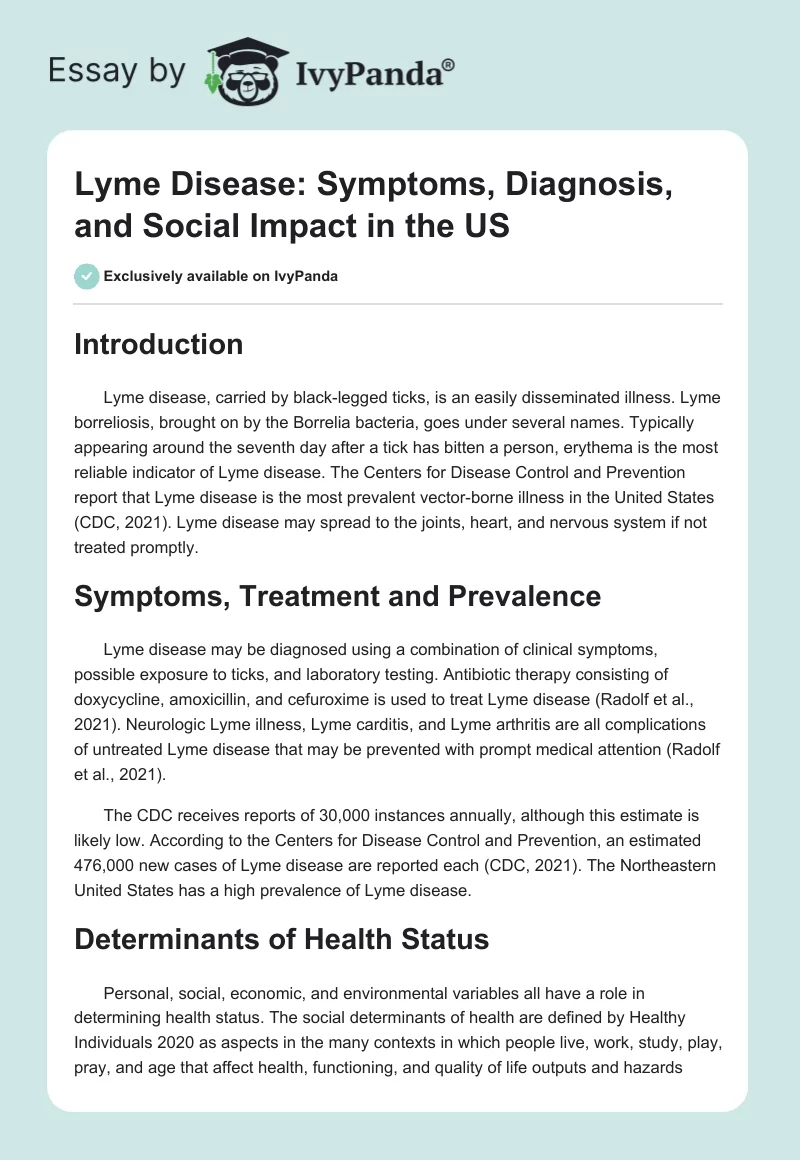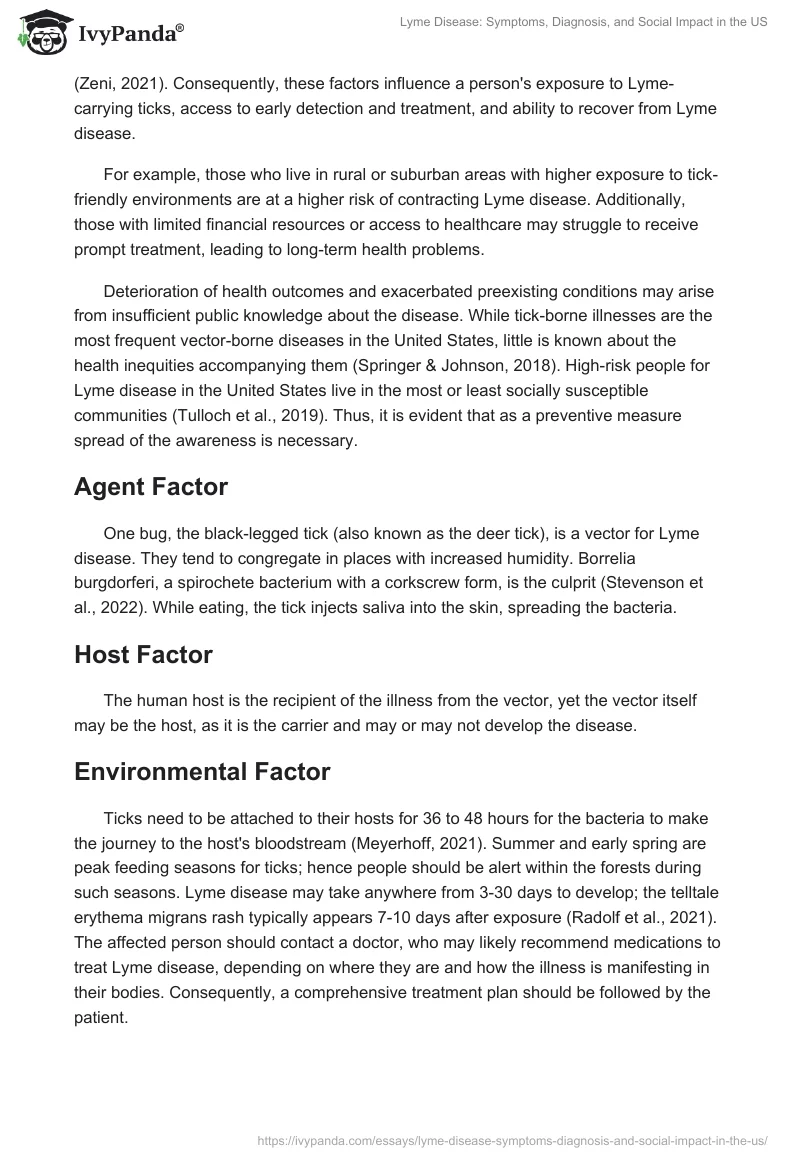Introduction
Lyme disease, carried by black-legged ticks, is an easily disseminated illness. Lyme borreliosis, brought on by the Borrelia bacteria, goes under several names. Typically appearing around the seventh day after a tick has bitten a person, erythema is the most reliable indicator of Lyme disease. The Centers for Disease Control and Prevention report that Lyme disease is the most prevalent vector-borne illness in the United States (CDC, 2021). Lyme disease may spread to the joints, heart, and nervous system if not treated promptly.
Symptoms, Treatment and Prevalence
Lyme disease may be diagnosed using a combination of clinical symptoms, possible exposure to ticks, and laboratory testing. Antibiotic therapy consisting of doxycycline, amoxicillin, and cefuroxime is used to treat Lyme disease (Radolf et al., 2021). Neurologic Lyme illness, Lyme carditis, and Lyme arthritis are all complications of untreated Lyme disease that may be prevented with prompt medical attention (Radolf et al., 2021).
The CDC receives reports of 30,000 instances annually, although this estimate is likely low. According to the Centers for Disease Control and Prevention, an estimated 476,000 new cases of Lyme disease are reported each (CDC, 2021). The Northeastern United States has a high prevalence of Lyme disease.
Determinants of Health Status
Personal, social, economic, and environmental variables all have a role in determining health status. The social determinants of health are defined by Healthy Individuals 2020 as aspects in the many contexts in which people live, work, study, play, pray, and age that affect health, functioning, and quality of life outputs and hazards (Zeni, 2021). Consequently, these factors influence a person’s exposure to Lyme-carrying ticks, access to early detection and treatment, and ability to recover from Lyme disease.
For example, those who live in rural or suburban areas with higher exposure to tick-friendly environments are at a higher risk of contracting Lyme disease. Additionally, those with limited financial resources or access to healthcare may struggle to receive prompt treatment, leading to long-term health problems.
Deterioration of health outcomes and exacerbated preexisting conditions may arise from insufficient public knowledge about the disease. While tick-borne illnesses are the most frequent vector-borne diseases in the United States, little is known about the health inequities accompanying them (Springer & Johnson, 2018). High-risk people for Lyme disease in the United States live in the most or least socially susceptible communities (Tulloch et al., 2019). Thus, it is evident that as a preventive measure spread of the awareness is necessary.
Agent Factor
One bug, the black-legged tick (also known as the deer tick), is a vector for Lyme disease. They tend to congregate in places with increased humidity. Borrelia burgdorferi, a spirochete bacterium with a corkscrew form, is the culprit (Stevenson et al., 2022). While eating, the tick injects saliva into the skin, spreading the bacteria.
Host Factor
The human host is the recipient of the illness from the vector, yet the vector itself may be the host, as it is the carrier and may or may not develop the disease.
Environmental Factor
Ticks need to be attached to their hosts for 36 to 48 hours for the bacteria to make the journey to the host’s bloodstream (Meyerhoff, 2021). Summer and early spring are peak feeding seasons for ticks; hence people should be alert within the forests during such seasons. Lyme disease may take anywhere from 3-30 days to develop; the telltale erythema migrans rash typically appears 7-10 days after exposure (Radolf et al., 2021). The affected person should contact a doctor, who may likely recommend medications to treat Lyme disease, depending on where they are and how the illness is manifesting in their bodies. Consequently, a comprehensive treatment plan should be followed by the patient.
Conclusion
In conclusion, Lyme disease is a serious and easily spread illness caused by the black-legged tick and the Borrelia bacteria. It is the most prevalent vector-borne illness in the United States and may lead to serious complications if not treated promptly. Factors such as personal, social, economic, and environmental variables all play a role in determining a person’s risk of contracting the disease and their ability to receive early detection and treatment.
References
Centers for Disease Control and Prevention (CDC). (2021). Lyme Disease. CDC. Web.
Meyerhoff, J. (2021). Lyme Disease. Practice Essentials, Background, Etiology. Web.
Radolf, J. D., Strle, K., Lemieux, J. E., & Strle, F. (2021). Lyme disease in humans. Current issues in molecular biology, 42(1), 333-384. Web.
Springer, Y. P., & Johnson, P. T. (2018). Large-scale health disparities associated with lyme disease and human monocytic ehrlichiosis in the United States, 2007–2013. PLOS ONE, 13(9). Web.
Stevenson, B., Krusenstjerna, A. C., Castro-Padovani, T. N., Savage, C. R., Jutras, B. L., & Saylor, T. C. (2022). The consistent tick-vertebrate infectious cycle of the lyme disease spirochete enables Borrelia burgdorferi to control protein expression by monitoring its physiological status. Journal of Bacteriology, 204(5), e00606-21. Web.
Tulloch, J. S., Semper, A. E., Brooks, T. J., Russell, K., Halsby, K. D., Christley, R. M., Radford, A. D., Vivancos, R., & Warner, J. C. (2019). The demographics and geographic distribution of laboratory-confirmed lyme disease cases in England and Wales (2013–2016): An ecological study. BMJ Open, 9(7). Web.
Zeni, M. B. (2021). Principles of Epidemiology for Advanced Nursing Practice: A Population Health Perspective. Jones & Bartlett Learning.


